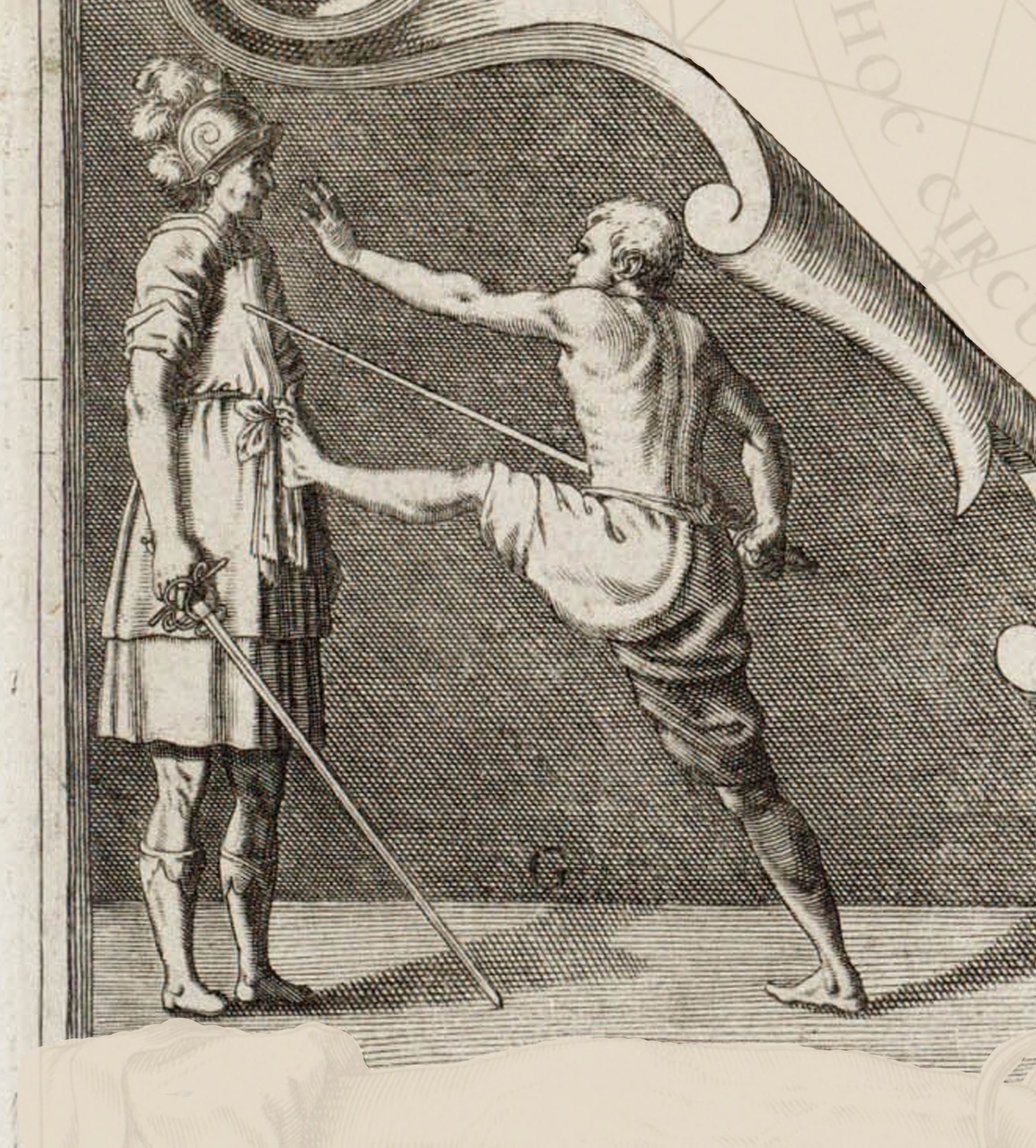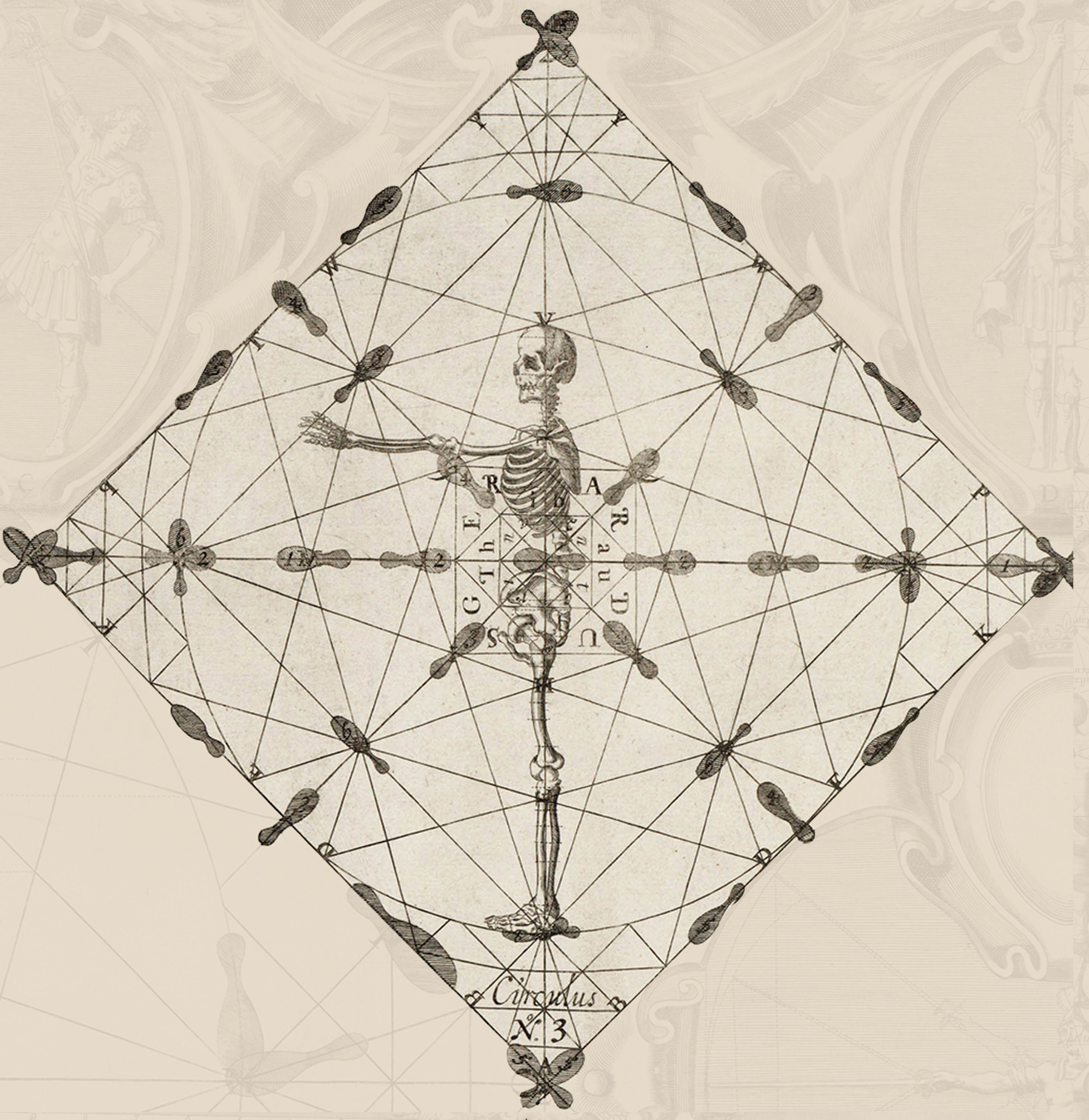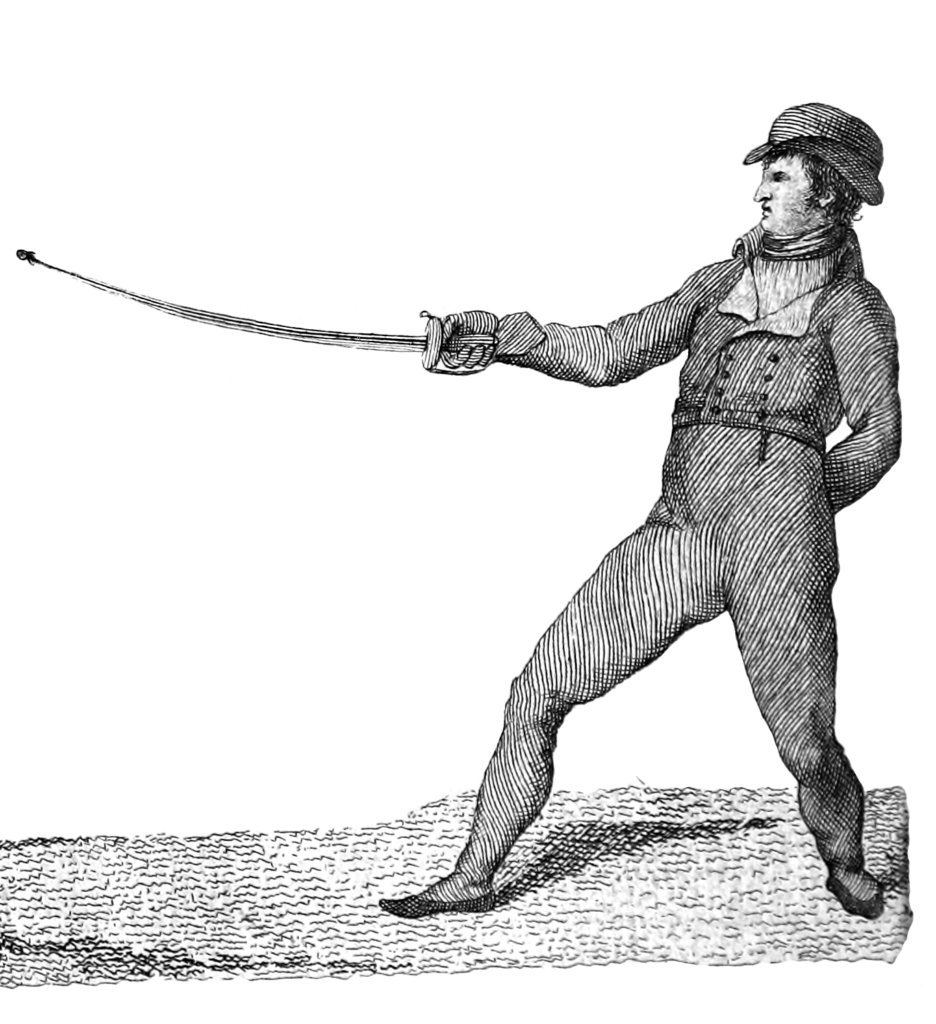223. After having given, in the previous chapter, all of the rules which seemed advisable for security in battle, and to the nature of this treatise, I will make here a note to serve as an appendix to the previous rules, serving also to illustrate this part. Recall that in the treatment of the deep steps, I described two circles of the offensive measure, the interior being four and a half feet from its center and the exterior five. The distance from the first is that provided for cutting wounds, and the second is for the point.
224. Battles that exceed two shots will never be made only of wounds of the point, but the second, or at least the third, is a cut. Take care that the first one is a thrust, because cuts thrown from defensive measure are unsafe. This need to mix thrusts and cuts is the result of using diverse steps. To facilitate, then, this combination, whenever you plan a cutting blow, make in the preceding thrust a half step advance with the left foot at the same time as the deep step, and any of those leaving the line of the diameter on either side by two feet, so that in the second shot, it will be easy for the right foot to occupy the inner circle or offensive measure for cuts.
225. To keep the best possible order in the battles that I will describe, begin in the guard of third, attacking with a thrust, and passing after to that of fourth, etc. I shall observe in them the same method that I observed in the battles of two shots. This consists of attacking for second, any of the points that are uncovered in the removals that are made to the executions on the guards and that can be permitted to invade from below the guard, going after to the wounds that are formed by the point, so that in the discourse of this part we will see however many points are uncovered in all of the removals, executing in them, however many offenses and defenses are insinuated, reserving others for a more opportune occasion.
First Battle:
Thrust of Fourth, of Third, and Counter Edge Blow to the Wrist
226. The seven battles I have put in this chapter all begin by attacking the enemy on the guard of third with a thrust of fourth, attacking in the stated order, the points which the opponent uncovers on the remove of the same number, with which they repair the thrust, and to more of these which the second removal provides. Keep this notice in mind as it will not be repeated in each battle of the guard of third.
227. The combatants fixed in the defensive measure, the one disposed to attack his competitor from the offensive stance with the sabre in the common guard, and the other to defensive in his stance, carrying the enemy’s sabre to the guard of third to take the point outside of the right vertical. The one who attacks will free his weapon from below the other, turning, with a deep step a thrust of fourth without omitting any of the oppositions of the planes, arm, etc, and when his competitor goes to the removal of fourth, free again to the outside, balancing at the same time to the rear and repeating a thrust of third, returning to balance forward at the time of the execution, moving to square, etc. The removal of this thrust will be with third of the second order, then, the attacker will walk his right foot at once to point A, Plate 2, with the left following immediately to the corresponding place, placing the counter edge of his weapon in the place below the enemy’s arm and, pulling strongly upward, make a Spanish leap back, cutting the wrist at the same time. If the removal of third is open, omit leaving the line, making only the withdrawing cut.
228.The counter edge blow is removed with low fourth with the arm extended or with low fifth, moving always to square. You can execute, in place of the counter edge blow, a reverse to the leg, or a horizontal cut to the abdomen.
Second Battle:
Thrust of Fourth, Half Reverse, and Diagonal Cut
229. To throw this thrust of fourth, make the deep step, advancing the left foot a half step. After the opposite repairs it, turn the hand fully into third without disengaging the sabres, for which it will be necessary to move square but, at the same time as the motion off of the line to the left side, execute a half reverse formed from below the guard.
230. Removing this half reverse requires the collection of high third, and to make it you must turn your hand fully to third, join your elbow to your right vertical, raise the point of your sabre higher than the supreme plane, move square, and take your left foot out on its diagonal. After this operation is completed by the one who removes, the one that attacks will repeat, with the motion of profile, a diagonal cut to the face without wasting time on the recovery. Remove this last blow with high fourth. If the second removal of high third is higher than necessary, you can execute third a thrust of second.
Third Battle:
Thrust of Fourth, Vertical Cut, and Reverse to the Thigh
231. The enemy having repaired with fourth, the first thrust executed with the advance as said from the previous battle, leave the line under the circumstances from the previous second thrust and free from below the contrary’s arm. Execute a vertical cut to the head or shoulder, which is repaired with high third, moving the left foot on your diagonal to give disposition for a reverse to the thigh with a leap back, inclining the body forward, you will take the necessary distance for its achievement, recovering immediately.
232. To remove this reverse, simply retire the leg a step or just extend it. Instead of this reverse, the third wound can be thrown as a diagonal cut to the left side, formed by the point.
Fourth Battle:
Thrust of Fourth, Half Cut, and Thrust of Second
233. Suppose that the enemy repaired the first thrust with the removal of fourth. Make the operation of stepping and movement of the arm explained in the second shot of the two previous fights and, freeing from below, execute a diagonal cut to the face. The one who would move with high third and motion on the left diagonal, as executed in the previous second removals uncovers the points for the thrust of second.
234. This thrust of second can be removed with low fifth, but the guard, in this case, should remain at the height of the superior plane. If the contrary removes the diagonal cut with high fourth, choose for a third shot a half cut to the arm or to the leg.
Fifth Battle:
Thrust of Fourth, Half Cut, and Reverse to the Arm
235. If the parry of fourth with which the enemy eluded the first thrust was made lowering the point below the superior plane and closed, leave the line of the attack on the left side the stated distance, freeing the point to inflict a half cut to the neck or face. To remove this blow from the removal of fourth, which it is on, turn the hand fully to third and lower the point of the sabre in order to make the removal of first without motion of the planes.
236. In virtue of the first that the enemy has made, having raised the point of the sabre until it is perpendicular to the contrary’s arm, and from here making a Spanish leap back, cut him with a blow to the wrist. Remove this wound with high third, seeking with the left foot the line of the diameter that the contrary chose or, likewise, move over the left diagonal at the same time. Instead of the cut to the arm, you can throw a thrust of second or a diagonal reverse to the abdomen.
Sixth Battle:
Thrust of Fourth, Diagonal Reverse, and Half Reverse
237. The enemy finishes repairing the first thrust with fourth and, by this action, has uncovered enough points to leave the line by the left side, forming by the point with a little bend of the arm, a diagonal reverse to the face, which is repaired with high third, taking the left foot on its diagonal, uncover the arm to achieve on it a horizontal half reverse, going out at the same time with a Spanish leap back.
238. The final shot is repaired with low fifth. If the second removal was very high, take, for the third offense, a diagonal cut to the face or the body, with no need to leave the line.
Seventh Battle:
Thrust of Fourth, Diagonal Reverse, and Vertical Cut
239. Suppose that the enemy has repaired the first blow with the removal of fourth. The attacker will immediately leave the line to the left side and execute a diagonal reverse to the body. This is removed with second, moving to square, taking the left foot on the diagonal which give the attacker disposition to profile, directing a vertical cut to his head, recovering with greatest violence. Remove this cut with high first, covering the head (§ 179). But if there is enough strength and agility of wrist, remove with high third.
240. You can execute, for the last shot of the battle, the thrust of first, for which it is necessary after the contrary has formed his removal of second, to balance backward and, freeing above, lean forward again throwing the thrust. Without the stated inclination, the reach will be missing. For this reason it should not be omitted. If the enemy balances to the rear in the second removal, advance freely with the left foot and execute a step with the right.























